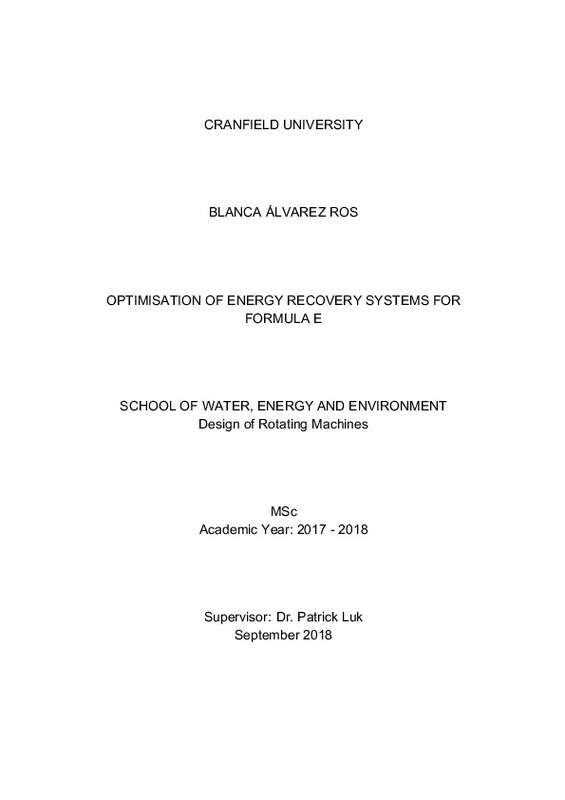JavaScript is disabled for your browser. Some features of this site may not work without it.
Buscar en RiuNet
Listar
Mi cuenta
Estadísticas
Ayuda RiuNet
Admin. UPV
Optimización de un sistema de recuperación de energía en un Formula E
Mostrar el registro sencillo del ítem
Ficheros en el ítem
| dc.contributor.advisor | Montalva Subirats, José Miguel
|
es_ES |
| dc.contributor.author | Álvarez Ros, Blanca
|
es_ES |
| dc.date.accessioned | 2020-04-20T19:11:35Z | |
| dc.date.available | 2020-04-20T19:11:35Z | |
| dc.date.created | 2018-09-03 | |
| dc.date.issued | 2020-04-20 | es_ES |
| dc.identifier.uri | http://hdl.handle.net/10251/141016 | |
| dc.description.abstract | [ES] Con el principal objetivo de reducir las emisiones de CO2, en 2009 el primer sistema de recuperación de energía fue diseñado y puesto en marcha dentro de un monoplaza de Formula 1. Dicho evento marcó un antes y un después dentro del sector del motor, puesto que supuso el nacimiento los primeros motores híbridos dentro de dicha competición. Actualmente, los vehículos de Formula E, puramente eléctricos, están equipados con dicho sistema y representa una parte crucial, que debe ser diseñado de manera muy precisa para lograr optimizar la disponibilidad de energía. El presente proyecto tiene como objeto estudiar en detalle los requisitos energéticos del vehículo en determinadas condiciones, junto con las limitaciones de la FIA, en cuanto a lo que energía disponible para almacenar y generación de potencia se refiere, que determinarán las estrategias de diseño a seguir para el motor y sistema de transmisión. Además, los sistemas de almacenamiento de energía también serán objeto de estudio y se diseñarán diversas configuraciones a partir de ultra-condensadores y baterías de ion-litio. En la actualidad, los Formula E cuentan con baterías del tipo ion-litio (NMC), sin embargo, sistemas híbridos que combinen diferentes dispositivos de almacenamiento serán, también, objeto de análisis con la finalidad de compararlos con los actuales y demostrar cualquier posible ventaja que puedan ofrecer para el caso de estudio. Examinando todas las alternativas, solo una de las citadas configuraciones se demostrará ser la solución óptima, teniendo en cuenta sus principales prestaciones tales como el peso, la autonomía, la energía almacenada y la potencia generada. | es_ES |
| dc.description.abstract | [EN] With the main purpose of reducing CO2 emissions, in 2009 the first energy recovery system was designed and set in motion inside a Formula 1 single-seated. Said event marked a milestone inside the motorsports field, since the first hybrid engines inside the industry were born. Currently, Formula E vehicles pure electric vehicles are equipped with said system and it represents a crucial part, which needs to be accurately designed in order to optimise the energy availability. The present project aims to study in detail the energy requirements under certain conditions and the FIA limitations specially in energy storage and power generation , which will determine the design strategy to follow, regarding the design of the propeller and transmission system. Moreover, the energy storage system is also studied in detail and several configurations from ultra-capacitors and NMC batteries are designed. Currently, Formula E is using exclusively Lithium-Ion batteries, however, hybrid systems are also object of study in order to compare their performance with the current ones and demonstrate their possible advantages for the present application. Examining all the alternatives, only one of said configurations is probed to be the optimal solution, accounting their weight, range, energy stored and power generation. | es_ES |
| dc.language | Inglés | es_ES |
| dc.publisher | Universitat Politècnica de València | es_ES |
| dc.rights | Reserva de todos los derechos | es_ES |
| dc.subject | Sistema de recuperación de energía | es_ES |
| dc.subject | Sistema de almacenamiento de energía | es_ES |
| dc.subject | Formula E | es_ES |
| dc.subject | Baterías de ion-litio | es_ES |
| dc.subject | Ultra-condensadores | es_ES |
| dc.subject | Energy recovery system | es_ES |
| dc.subject | Energy storage system | es_ES |
| dc.subject | NMC batteries | es_ES |
| dc.subject | Ultra-capacitors. | es_ES |
| dc.subject.classification | INGENIERIA DE LA CONSTRUCCION | es_ES |
| dc.subject.other | Máster Universitario en Ingeniería Industrial-Màster Universitari en Enginyeria Industrial | es_ES |
| dc.title | Optimización de un sistema de recuperación de energía en un Formula E | es_ES |
| dc.type | Tesis de máster | es_ES |
| dc.rights.accessRights | Abierto | es_ES |
| dc.contributor.affiliation | Universitat Politècnica de València. Departamento de Ingeniería de la Construcción y de Proyectos de Ingeniería Civil - Departament d'Enginyeria de la Construcció i de Projectes d'Enginyeria Civil | es_ES |
| dc.contributor.affiliation | Universitat Politècnica de València. Escuela Técnica Superior de Ingenieros Industriales - Escola Tècnica Superior d'Enginyers Industrials | es_ES |
| dc.description.bibliographicCitation | Álvarez Ros, B. (2018). Optimización de un sistema de recuperación de energía en un Formula E. http://hdl.handle.net/10251/141016 | es_ES |
| dc.description.accrualMethod | TFGM | es_ES |
| dc.relation.pasarela | TFGM\94616 | es_ES |
Este ítem aparece en la(s) siguiente(s) colección(ones)
-
ETSII - Trabajos académicos [10528]
Escuela Técnica Superior de Ingenieros Industriales






